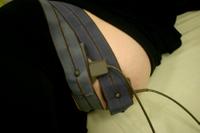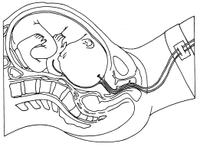While labour is a normal process, it is also unpredictable. During labour and birth, your caregiver may need to recommend one or more medical procedures to help you or your baby. We’ve outlined the benefits and risks of the more common procedures below. When you are in labour it may be difficult to focus on the explanations, so ask your caregiver early in your pregnancy to explain these and other procedures that you may need.
Fetal Monitoring
Electronic fetal monitoring is done to make sure your baby is well. This procedure is advised for all women for short periods of time.
External
- Two belts with sensors are placed around your abdomen. One sensor measures your baby’s heart rate, the other measures your contractions. The measurements are printed on to a graph that your caregivers use to assess your labour and how your baby is reacting to it.This can be done in many positions in the bed, on the birth ball or in a chair.
- Your nurse will listen to your baby’s heart rate periodically throughout your labor using a doppler or a fetoscope. The doppler can be used in the shower.
Internal
- Internal fetal monitoring may be advised if there is a concern about the baby’s health or if they are unable to get an accurate reading with the external fetal monitor. This is a more accurate way of listening to your baby’s heart rate.
- A small electrode is attached to your baby’s scalp by a very thin wire. The electrode is applied through your vagina, after your cervix has opened and the amniotic sac (bag of waters) has broken.
- The baby may have some bruising and a small scab where the wire was attached. Although electronic fetal monitoring does not cause discomfort, you won’t be able to move around a lot while it’s being done.

